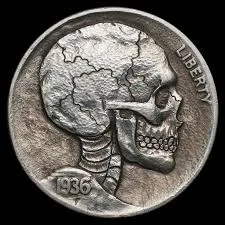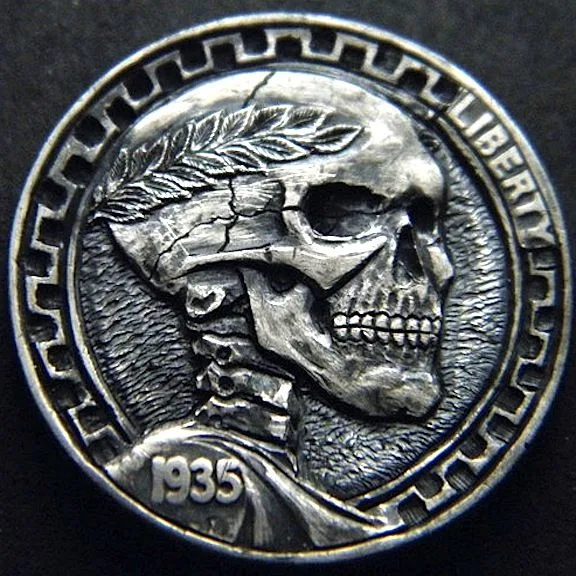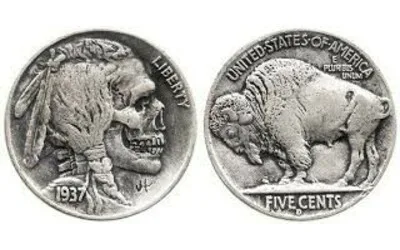During the Great Depression of the 1930s, amidst widespread poverty and hardship, a unique form of folk art emerged in the United States: the Hobo Nickel. These hand-engraved five-cent coins, transformed by homeless individuals known as hobos, turned ordinary nickels into intricate works of art. Crafted with remarkable skill, these miniature masterpieces, often featuring motifs like skulls, were traded for food, rides, or small services, embodying both creativity and survival in a time of economic despair.

A Coin Reimagined
Hobo Nickels were born out of necessity. With little access to money, hobos—transient workers who roamed the country seeking work—used simple tools like knives, nails, or chisels to carve detailed designs into the Buffalo Nickel, a coin minted from 1913 to 1938. By altering the coin’s surface, typically the obverse featuring the Indian head, they created unique pieces that held greater value than their nominal five cents. Common motifs included portraits, animals, and, notably, skulls, as seen in the referenced example, which added a striking, macabre flair to the coin.

The skull motif, with its grim yet artistic appeal, reflected the era’s stark realities while showcasing the engraver’s skill. These designs often replaced the coin’s original imagery, transforming the stoic Indian head into a grinning skeleton or other imaginative figures. Each nickel was a one-of-a-kind creation, its value derived from the craftsmanship and the story it told.
A Symbol of Resilience
Creating a Hobo Nickel was no small feat. The process required patience, precision, and artistry, as hobos worked with crude tools under challenging conditions—often by firelight or in makeshift camps. The Buffalo Nickel’s soft nickel composition made it ideal for carving, but the intricate details, from etched bones to expressive faces, demanded a steady hand. These coins were more than art; they were a currency of survival, bartered for meals, shelter, or a ride on a freight train.
The Great Depression, triggered by the 1929 stock market crash, left millions jobless and homeless. Hobos, traveling across the U.S. in search of work, developed a subculture with its own codes and creativity. The Hobo Nickel became a hallmark of this resilience, turning a common coin into a token of ingenuity and hope.
A Collector’s Treasure
Today, Hobo Nickels are prized collectibles, valued for their historical significance and artistic merit. Original pieces from the Depression era, particularly those with detailed designs like skulls, can fetch thousands of dollars at auction. For example, high-quality originals by renowned hobo artists like “Bo” (George Washington Hughes) have sold for upwards of $5,000, according to auction records from the Original Hobo Nickel Society. Modern reproductions exist, but collectors seek the authentic, hand-carved nickels, identifiable by their wear, patina, and unique imperfections.
The skull motif, as seen in the referenced nickel, remains one of the most iconic designs, symbolizing both the era’s mortality and the artist’s defiance of it. These coins are displayed in museums, private collections, and exhibitions, celebrated as a testament to human creativity under adversity.

A Lasting Legacy
The Hobo Nickel is more than a relic of the Great Depression—it’s a story of survival, artistry, and resourcefulness. Each coin, like the skeleton-engraved example, carries the weight of its creator’s struggle and imagination. In transforming a humble nickel into a work of art, hobos left a legacy that continues to captivate, reminding us that even in the darkest times, creativity can shine through, offering both sustenance and a lasting mark on history.





